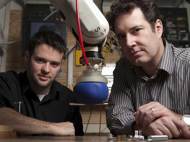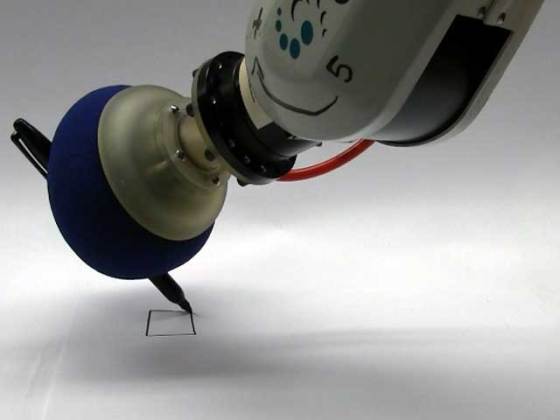Balloon filled with ground coffee makes for versatile robotic gripper
 We mostly take it for granted, but human hand is amazing because it enables us to interact with many objects with ease. Opting for simple elegance, researchers from Cornell University, the University of Chicago and iRobot Corp. have created a versatile gripper using everyday ground coffee and a latex party balloon, bypassing traditional designs based on the human hand and fingers.
We mostly take it for granted, but human hand is amazing because it enables us to interact with many objects with ease. Opting for simple elegance, researchers from Cornell University, the University of Chicago and iRobot Corp. have created a versatile gripper using everyday ground coffee and a latex party balloon, bypassing traditional designs based on the human hand and fingers.
“They call it a universal gripper, as it conforms to the object it’s grabbing, rather than being designed for particular objects”, said Hod Lipson, Cornell associate professor of mechanical engineering and computer science. The research is a collaboration between the groups of Lipson, Heinrich Jaeger at the University of Chicago, and Chris Jones at iRobot.
An everyday party balloon filled with ground coffee is attached to a robotic arm. The coffee-filled balloon presses down and deforms around the desired object, and then a vacuum sucks the air out of the balloon, solidifying its grip. When the vacuum is released, the balloon becomes soft again, and the gripper lets go.
You might have noticed that vacuum-packed coffee can’t budge much until the seal is opened. This occurs because coffee is an example of a particulate material, which is characterized by large aggregates of individually solid particles. Particulate materials have a so-called “jamming transition”, which turns their behavior from fluid- to solid-like when the particles can no longer slide past each other.
Jaeger explained that the concept of a jamming transition provides a unified framework for understanding and predicting behavior in a wide range of disordered, amorphous materials. All of these materials can be driven into a “glassy” state where they respond like a solid yet structurally resemble a liquid, and this includes many liquids, colloids, emulsions or foams, as well as particulate matter consisting of macroscopic grains.
Eric Brown, a postdoctoral researcher, and Nick Rodenberg, a physics undergraduate, worked with Jaeger on characterizing the basic mechanisms that enable the gripping action. Prototypes of the gripper were built and tested by Lipson and Cornell graduate student John Amend, as well as at iRobot.
“As for the right particulate material, anything that can jam will do in principle, and early prototypes involved rice, couscous and even ground-up tires”, Amend said. They settled on coffee because it’s light and it performs well, Sand did better on jamming but was prohibitively heavy. What sets the jamming-based gripper apart is its good performance with almost any object, including a raw egg or a coin (both notoriously difficult for traditional robotic grippers).
Due to universality of the gripper, the future applications are seemingly limitless, from the military using it to dismantle explosive devises or to move potentially dangerous objects, robotic arms in factories, on the feet of a robot that could walk on walls, or on prosthetic limbs.










Leave your response!